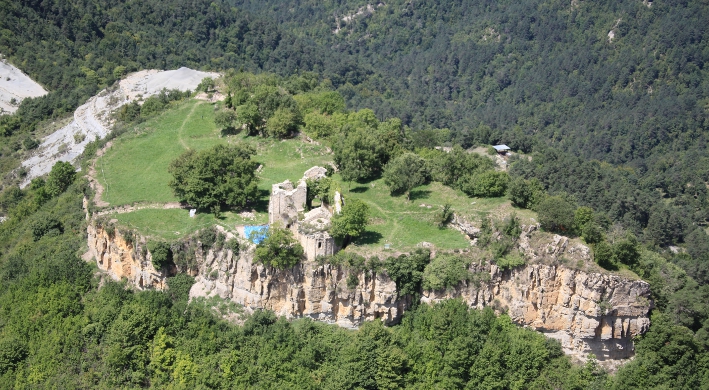Besora's Castle monumental complex

Besora's Castle monumental complex and the church of Santa Maria is located in the northwest of the municipality of Santa Maria de Besora, in Bisaura, halfway between Osona and Ripollès. It is located on the top of the hill to which it has given its name, of an approximate area of one hectare, which rises to 1,092 meters above sea level and is surrounded by a cliff in all its eastern and southern slopes. It is reached on foot, by a steep and winding road that begins in the plan of Teià, in the same town.
It is declared a Cultural Asset of National Interest, in the category of Historical Monument. In addition, it is located within the Area of Natural Interest (EIN) of Sierras de Milany - Santa Magdalena - Puigsacalm - Bellmunt.
Apart from its scenic beauty, it constitutes a group of great historical and monumental interest. The church of Santa María, which occupies the extreme east and has the apse on the edge of the cliff, can be seen from the town of Santa Maria.
The church was built on the remains of a primitive church of the ninth century. The 11th century belfry stands out for its solidity and, for its beauty, the arcaded atrium dating from the 12th century. During the sixteenth century it was renovated and enlarged with chapels, until April 25, 1838, according to a document from the parish archive, the roof was dynamited to prevent the Carlists from fortifying themselves.
The other building that is standing is located in the northwest of the esplanade and is the remains of what was the castle. Several rooms are observed, probably intended for domestic use and reformed during the modern era.
Since 2005 and up to the present, promoted by the Private Foundation of the Monumental Complex of Besora's Castle, the Association of Friends of Bisaura and ATICS SL, together with the City Council of Santa Maria de Besora, the UAB and the Generalitat of Catalonia , various actions have been carried out in order to better understand the history of the monument and at the same time value it. On the one hand, they have been able to consolidate the walls of the church to avoid its degradation and, on the other, archaeological and anthropological studies have been carried out.